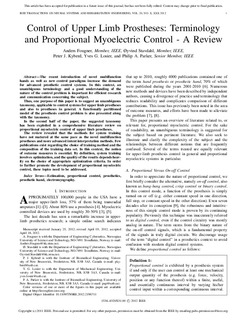| dc.contributor.author | Fougner, Anders Lyngvi | |
| dc.contributor.author | Stavdahl, Øyvind | |
| dc.contributor.author | Kyberd, Peter Joseph | |
| dc.contributor.author | Losier, Yves G. | |
| dc.contributor.author | Parker, Philip A. | |
| dc.date.accessioned | 2014-05-07T09:23:30Z | |
| dc.date.accessioned | 2016-06-10T12:22:40Z | |
| dc.date.available | 2014-05-07T09:23:30Z | |
| dc.date.available | 2016-06-10T12:22:40Z | |
| dc.date.issued | 2012 | |
| dc.identifier.citation | IEEE transactions on neural systems and rehabilitation engineering 2012, 20(5):663-677 | nb_NO |
| dc.identifier.issn | 1534-4320 | |
| dc.identifier.uri | http://hdl.handle.net/11250/2392275 | |
| dc.description.abstract | The recent introduction of novel multifunction hands as well as new control paradigms increase the demand for advanced prosthetic control systems. In this context, an unambiguous terminology and a good understanding of the nature of the control problem is important for efficient research and communication concerning the subject.
Thus, one purpose of this paper is to suggest an unambiguous taxonomy, applicable to control systems for upper limb prostheses and also to prostheses in general. A functionally partitioned model of the prosthesis control problem is also presented along with the taxonomy.
In the second half of the paper, the suggested taxonomy has been exploited in a comprehensive literature review on proportional myoelectric control of upper limb prostheses.
The review revealed that the methods for system training have not matured at the same pace as the novel multifunction prostheses and more advanced intent interpretation methods. Few publications exist regarding the choice of training method and the composition of the training data set. In this context, the notion of outcome measures is essential. By definition, system training involves optimization, and the quality of the results depends heavily on the choice of appropriate optimization criteria. In order to further promote the development of proportional myoelectric control, these topics need to be addressed. | nb_NO |
| dc.language.iso | eng | nb_NO |
| dc.publisher | IEEE | nb_NO |
| dc.relation.uri | http://dx.doi.org/10.1109/TNSRE.2012.2196711 | |
| dc.title | Control of Upper Limb Prostheses: Terminology and Proportional Myoelectric Control-A Review | nb_NO |
| dc.type | Journal article | nb_NO |
| dc.type | Peer reviewed | nb_NO |
| dc.date.updated | 2014-05-07T09:23:31Z | |
| dc.subject.nsi | VDP::Teknologi: 500::Medisinsk teknologi: 620 | nb_NO |
| dc.subject.nsi | VDP::Technology: 500::Medical technology: 620 | nb_NO |
| dc.subject.nsi | VDP::Teknologi: 500::Informasjons- og kommunikasjonsteknologi: 550::Teknisk kybernetikk: 553 | nb_NO |
| dc.subject.nsi | VDP::Technology: 500::Information and communication technology: 550::Technical cybernetics: 553 | nb_NO |
| dc.source.pagenumber | 663-677 | nb_NO |
| dc.source.volume | 20 | nb_NO |
| dc.source.journal | IEEE transactions on neural systems and rehabilitation engineering | nb_NO |
| dc.source.issue | 5 | nb_NO |
| dc.identifier.doi | 10.1109/TNSRE.2012.2196711 | |
| dc.identifier.cristin | 926195 | |
| dc.subject.keyword | Biomedisinsk instrumentering / Biomedical engineering | |
| dc.subject.keyword | Instrumentering / Instrumentation | |
| dc.subject.keyword | Proteser og implantater / Prostheses and Implants | |
| dc.description.localcode | (c) 2012 IEEE. Personal use of this material is permitted. Permission from IEEE must be obtained for all other users, including reprinting/ republishing this material for advertising or promotional purposes, creating new collective works for resale or redistribution to servers or lists, or reuse of any copyrighted components of this work in other works. | nb_NO |
